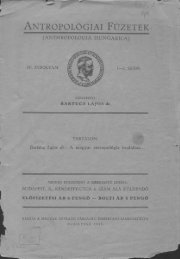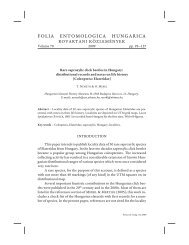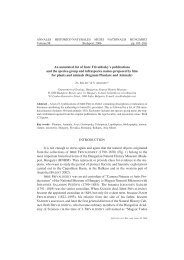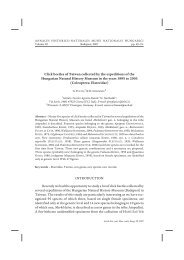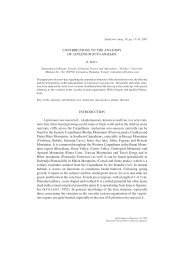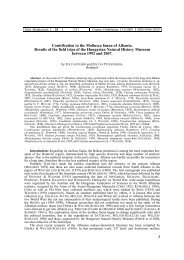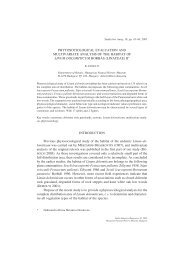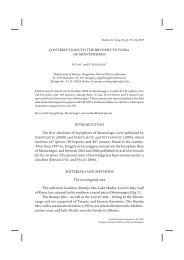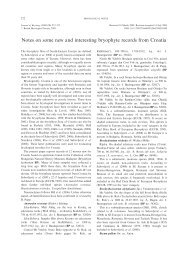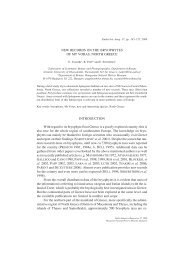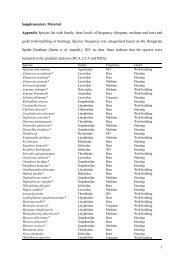THE GENUS SCHISTIDIUM (GRIMMIACEAE, MUSCI) IN HUNGARY ...
THE GENUS SCHISTIDIUM (GRIMMIACEAE, MUSCI) IN HUNGARY ...
THE GENUS SCHISTIDIUM (GRIMMIACEAE, MUSCI) IN HUNGARY ...
You also want an ePaper? Increase the reach of your titles
YUMPU automatically turns print PDFs into web optimized ePapers that Google loves.
<strong>THE</strong> <strong>GENUS</strong> <strong>SCHISTIDIUM</strong> <strong>IN</strong> <strong>HUNGARY</strong> 29<br />
Taxonomic characters<br />
– Visible in stem cross sections of sporophyte bearing plants. In<br />
sterile shoots, the central strand may not fully be developed.<br />
– Two types of hair-point can be distinguished (BLOM 1996):<br />
(1) (Figs 3C, 9C, E, 11B 15C, 23C, 25B): cell walls clearly visible; transverse section<br />
canaliculate, flattened or lens-shaped; hair-point irregularly bent or flexuose in the dry<br />
state (but straight in S. dupretii and S. confusum). (2) (Figs 5E, 7B, E, 13C, 17E, 21C,<br />
30B, C, 32B, D): cell walls usually not clearly visible; transverse section lens-shaped or<br />
terete; hair-point usually straight.<br />
– Sinuose (e.g. in S. robustum, Fig. 32E) or esinuose, size in different<br />
parts of leaf (basal, central and apical) is also important.<br />
– Hemispherical or conical cell wall structures on leaf lamina (Figs 11E,<br />
25F, 30G, H), costa and margins (Figs 3B, 13B–D, 15C, 23B, C, E, 28B, 30B, C). Since in<br />
papillose species only a fraction of lamina cells bear papillae, papillosity is a property of the<br />
lamina, not of cells. Young leaves should be examined for papillosity.<br />
K+ – Upper leaves torn off the stem and placed in a drop of 2% KOH solution develop<br />
either yellow (in Confertum group) or red (in all other taxa) colours.<br />
– These important characters<br />
are best assessed in empty capsules soaked in 2% KOH solution, because after this procedure<br />
even old, fragile or damaged capsules assume their original shape, the capsule wall<br />
becomes less fragile and can thus be cut more easily, and the pattern of exothecial cells and<br />
stomata will also become much clearer. If only green, unripe capsules are available, these<br />
should be boiled for a short time in 2% KOH solution and then cut and emptied for examination<br />
of exothecial cells and stomata; however their shape and size will not correspond to<br />
that of ripe, emptied urns.<br />
Urn form may be the widest at the mouth (e.g. S. platyphyllum, Fig. 27D) or about the<br />
middle (e.g. S. elegantulum, Fig. 17F); measurements of length and width are important in<br />
absolute terms (e.g. for the differentiation between S. apocapum and S. lancifolium, compare<br />
Figs 3E and 23F) as well as their ratio. Measurements should be taken under a stereomicroscope<br />
without flattening the urn.<br />
The pattern of exothecial cells must be carefully observed in different parts of the<br />
capsule (see Fig. 1C–E), most relevant is the pattern in the lower half, especially at the base<br />
immediately above the seta, where the stomata may be observed. The pattern of seta surface<br />
cells is also sometimes useful (e.g. in the Rivulare group, Fig. 27G, 28F; BREMER 1980).<br />
In some taxa, ripe emptied urns may show a very fine striolation due to the arrangement<br />
of exothecial cells in vertical rows (Fig. 1). Transverse sections of the capsule wall<br />
(Fig. 1A) show an exothecium of even thickness, as in the capsule walls of Grimmia species<br />
(MAIER 2004). Sometimes (e.g. in S. dupretii) striolae develop due to the fact that long narrow<br />
exothecial cells, alternating with shorter cells, collapse (Fig. 15I, J). These striolae are<br />
not comparable to the plicae in the urns of other genera, e.g. Orthotrichum (MAIER 2004).<br />
– Orientation of peristome teeth should be observed in freshly<br />
deoperculate capsules. Peristome teeth may be patent to spreading with ascending tips<br />
Studia bot. hung. 39, 2008



